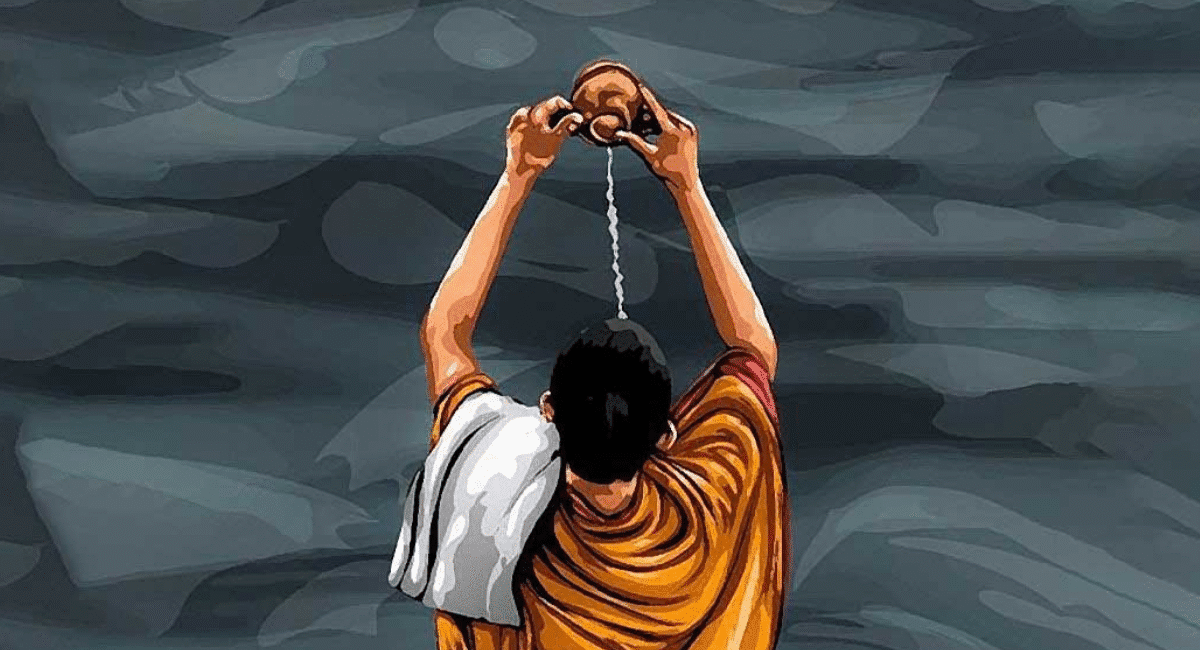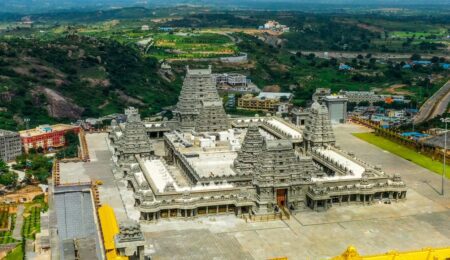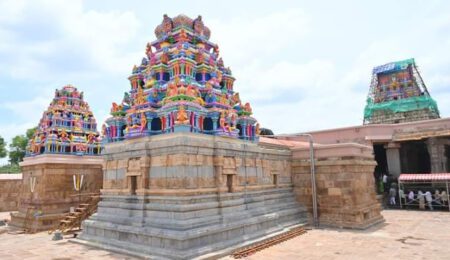The Spiritual Meaning of Pitru Paksha: Why We Perform Shraddha
Introduction: What Is Pitru Paksha & Why Shraddha Matters
Pitru Paksha, often called the “fortnight of ancestors,” is a revered Hindu period lasting sixteen lunar days, observed annually by countless families across India and the diaspora. This sacred time is dedicated to paying homage to deceased ancestors through a series of rituals known collectively as Shraddha. The term Pitru Paksha literally means “ancestor’s fortnight,” marking a window during which it is believed that the souls of forefathers visit the earthly realm seeking offerings and remembrance,
Shraddha, the primary observance of Pitru Paksha, is much more than a ritual of obligation. It embodies gratitude, remembrance, and the spiritual repayment of a debt known as Pitru Rin the debt owed to one’s ancestors for their guidance, life, and lineage. Performing Shraddha rituals is believed to bring peace to the departed souls and blessings to the living descendants, fostering prosperity, longevity, and spiritual wellbeing.
Beyond its religious roots, Pitru Paksha serves as a bridge between generations, offering a time for families to reconnect with their heritage, reflect on the sacrifices of their forebears, and impart these values to the next generation. Whether through elaborate ceremonies at sacred sites or simple acts of remembrance at home, Shraddha remains a poignant expression of love, faith, and spiritual continuity.
Historical & Mythological Background: Legends, Puranas, and Scriptural Roots
The significance of Pitru Paksha and Shraddha draws upon ancient legends, epic tales, and scriptural mandates that have shaped Hindu spiritual consciousness for millennia. Central among these stories is the widely recounted legend of Karna from the Mahabharata. Karna, celebrated for his unrivaled charity and valor, finds himself offered gold instead of food in heaven. Upon inquiry, Yama, the god of death, reveals that although Karna had given away copious wealth, he never donated food or water to his ancestors. Moved by his distress, Yama grants Karna 16 days on earth to make ancestral offerings, thus establishing the tradition of Pitru Paksha.
Scriptures such as the Garuda Purana, Vishnu Purana, and Markandeya Purana extensively elaborate on the importance of Shraddha, Tarpana (water offerings), and Pinda Daan (offering of rice balls). The Garuda Purana emphasizes that without proper Shraddha, ancestors remain restless and family lineage may face obstacles or Pitru Dosha an ancestral karmic imbalance. The Markandeya Purana further states that satisfied ancestors bestow longevity, prosperity, and knowledge upon their descendants.
Other tales from the epics and Puranas reinforce this message. The story of Bhishma, who postponed his death to depart during the auspicious Pitru Paksha, highlights the belief that dying or performing rituals in this period assures spiritual advancement and the ancestors’ happiness. Puranic texts also mention practices tailored to specific circumstances such as Shraddha for those who died untimely or unnatural deaths, and special offerings for mothers (Matru Shraddha) or renunciates.
Examples from the Epics and Puranas:
- Garuda Purana: “By feeding Brahmins and performing Shraddha with devotion, the souls of ancestors reach peace and in turn bless their family with health and happiness.”
- Mahabharata (Anushasana Parva): “He who performs Shraddha attains prosperity, satisfaction, and longevity. The act not only relieves the ancestors but uplifts the performer spiritually.”
Scriptural references thus provide both the moral imperative and metaphysical foundation for observing Shraddha during Pitru Paksha, shaping it into a core element of Hindu dharma.
Key Takeaway: Shraddha is not merely a ritual it is a profound act of faith rooted in ancient scriptures, folklore, and the belief in intergenerational blessings.
Spiritual Significance: Why Shraddha Is Important for Ancestors and Devotees
Repaying “Pitru Rin” — the Debt to Ancestors
Hindu philosophy underscores three lifelong debts: to the gods (Deva Rin), to sages and teachers (Rishi Rin), and to ancestors (Pitru Rin). Of these, Pitru Rin is repaid through procreation and the observance of Shraddha. The act of honoring forefathers ensures the continuity of lineage and maintains harmony in the cycle of birth and rebirth.
During Pitru Paksha, the souls of three generations paternal and maternal are believed to descend from Pitriloka (the ancestral realm governed by Yama) to receive the offerings of their descendants. The satisfaction and nourishment provided during Shraddha are said to grant peace, release from karmic bondage, and even moksha (liberation) for the departed souls. For the living, performing these rituals is believed to open channels of prosperity, wisdom, inner peace, and the removal of obstacles, especially those arising from ancestral dissatisfaction (Pitru Dosha).
Blessings Through Spiritual Merit
The Garuda Purana states unequivocally that the blessings of satisfied ancestors can lead to:
- Good health
- Longevity
- Wealth and abundance
- Success and progeny
- Wisdom and clarity
Neglecting ancestral duties, conversely, is considered a cause of misfortune, unrest, and even repeated obstacles in one’s material and spiritual life.
Emotional and Psychological Dimensions
Modern psychology also recognizes the therapeutic value of ancestral remembrance. Rituals like Shraddha not only provide a formal structure for managing grief and loss but also cultivate a sense of belonging, continuity, and gratitude. Involving the next generation fosters respect for elders and ensures the perpetuation of cherished family values and traditions.
In Brief: Performing Shraddha during Pitru Paksha is a spiritual rite, an emotional anchor, and a practical means of honoring, healing, and uplifting both ancestors and current family members.
Rituals and Traditions: Detailed Guide to Shraddha Ceremonies
Pitru Paksha rituals vary slightly by region and tradition, but the core components remain constant everywhere centering on devotion, purity, and a deep sense of gratitude.
Timing & Preparation
- Dates: Pitru Paksha 2025 runs from September 7 to September 21, culminating in Sarva Pitru Amavasya the most auspicious day to honor all ancestors, especially if their death anniversaries (tithi) are unknown.
- Preparation: Observers rise early, take a ritual bath, don clean (preferably traditional) attire, and prepare sattvic (pure vegetarian) food. Items like darbha (kusha) grass, black sesame seeds, barley, and copper/silver/bronze vessels are used for sanctity and spiritual efficacy.
Key Rituals
1. Sankalpa (Vow): The host makes a sacred vow with folded hands, stating the intention to perform Shraddha for named ancestors.
2. Pinda Daan: Pindas balls made from rice, barley flour, til (black sesame), ghee, and honey are shaped and offered, symbolizing the physical body and sustenance for the departed souls.
3. Tarpan: Water mixed with black sesame, barley, and kusha grass is offered while reciting ancestor names and mantras, usually facing south. This act is believed to quench the spiritual thirst of forebears and is performed at a riverbank if possible, or at home if necessary.
4. Food and Offerings: Simple, freshly prepared vegetarian dishes are made often including rice, kheer (milk pudding), dal, pumpkin, greens, and seasonal fruits. Item choices reflect purity and are traditionally served on banana leaves.
5. Feeding Living Beings: Offerings are made to crows (messengers of Yama), cows, and dogs; feeding them is considered tantamount to feeding ancestors. Food is also offered to Brahmins or the needy, seen as embodiments of Pitru Devatas during the ritual.
6. Charity (Daan): Charitable acts donating food, clothes, money, even cows or land are recommended. The Garuda Purana mentions giving gifts, especially to Brahmins, as highly meritorious and spiritually rewarding acts.
7. Fasting and Simplicity: Observers maintain a sattvic diet, avoid celebratory activities, refrain from hair/nail cutting, and abstain from tamasic foods (meat, onion, garlic, alcohol, heavy grains), supporting an atmosphere of remembrance and purity.
Common Menu Items Table: Foods in Shraddha Offerings
| Dish | Spiritual Reason | Notes |
|---|---|---|
| Kheer (rice pudding) | Symbolizes prosperity | Must be freshly prepared, no leftovers |
| Rice | Base for Pinda and meal | Always offered to ancestors |
| Dal (moong/chana) | Easy to digest, purity element | Urad/chickpeas avoided as heavy/tamasic |
| Pumpkin, gourd | Symbolic for spiritual growth | Commonly used in many regions |
| Greens (saag) | Cleansing and vital energy | Seen as sattvic (promotes clarity) |
| Fruits (banana, apple) | Natural, offering sweetness | Seasonal and local fruits preferred |
The significance of each food item lies in its simplicity, purity, and resonance with the spiritual goals of the Shraddha ritual.
Complete Step-by-Step Ritual
- Bathe and wear clean clothes.
- Prepare the ritual area with pictures or symbols of ancestors, and set up offerings.
- Make Sankalpa, specifying the ancestor(s) and intention.
- Prepare and offer pinda daan, chanting ancestor names.
- Perform tarpan pour water with black sesame and barley, reciting mantras.
- Offer food to crows, cows, dogs, and then to Brahmins/needy.
- Distribute charity as per capacity food, clothes, grains, money, etc.
- Light a diya (lamp) pray for peace and protection for all ancestors.
Important Do’s & Don’ts Table
| Do’s | Don’ts |
|---|---|
| Offer sattvic food only | Avoid meat, onion, garlic, eggs, alcohol |
| Maintain purity in conduct | No celebrations, weddings, or purchases |
| Feed crows/Brahmins/needy | Don’t waste or disrespect food |
| Consult tithi for correct day | No hair/nail cutting on ritual days |
Even seemingly simple steps such as feeding a crow or performing charity carry deep spiritual import, reflecting both scriptural commandments and long-held cultural values19.
Regional Variations: How Pitru Paksha Is Observed Across India
Although the spiritual essence of Pitru Paksha remains uniform, ritual details can differ according to regional, linguistic, and community traditions.
North India
In the Hindi heartland (Uttar Pradesh, Bihar), Shraddha rituals often culminate with Pinda Daan at sacred sites like Gaya, Varanasi, and Allahabad (Prayagraj) on the banks of the Ganga or Yamuna. Mass ceremonies and fairs (melas) are common at these pilgrimage centers. Devotees from across India and abroad undertake arduous journeys to offer Shraddha in Gaya, considered the holiest for liberating ancestors across seven generations21.
Western India
Gujarat refers to Pitru Paksha as Kanagat, with regional tweaks in the rituals. In Maharashtra, families observe Shraddha at home or by rivers, focusing on sattvic meals and acts of charity. Mass food donations, called ‘bhandaras,’ are prevalent in both regions.
Eastern India
West Bengal’s Mahalaya marks the end of Pitru Paksha and the symbolic invitation of Goddess Durga to Earth. People wake early to recite Mahalaya mantras (Chandi Path), perform Tarpan on the banks of the Ganges, and honor forebears with prayers and food this day bridges solemn ancestral tribute with the joyous ushering in of Durga Puja.
Southern India
States like Tamil Nadu, Andhra Pradesh, and Kerala observe “Mahalaya Paksha” or “Mahalaya Amavasya” through riverbank rituals, lamp lighting, and unique food preparations often performed at Rameswaram and along the Godavari or Kaveri rivers. Local traditions include chanting regional mantras and honoring both paternal and maternal ancestors.
Sacred Sites Table
| Place | Significance | Ritual Highlight |
|---|---|---|
| Gaya, Bihar | Most sacred for Shraddha; Vishnupad Temple | Pinda daan grants liberation for seven generations |
| Varanasi/Kashi, UP | Moksha dham (liberation spot) | Pinda daan at Manikarnika Ghat, Pishachmochan |
| Haridwar | Pitru Tarpan at Kushavarta Ghat | Rituals at the banks of the Ganga |
| Pushkar, Rajasthan | Home to only Lord Brahma temple | Shraddha grants special merit |
| Trimbakeshwar, Nashik | Known for Pitru Dosha Nivaran | Pitru rituals at Godavari riverbank |
| Siddhpur, Gujarat | Sacred for Matru Shraddha (mothers) | Rituals at Bindu Sarovar |
| Rameswaram, Tamil Nadu | River, sea, and temple rituals | Pinda daan at Setu Karai or Agni Theertham |
Whether conducted at a famous ghat or in a quiet home, the sincerity of remembrance is what matters most.
Modern Relevance: Pitru Paksha in Today’s World
Adapting Shraddha to Contemporary Lifestyles
In an era of migration, nuclear families, and global dispersion, many wonder how to uphold ancestral traditions. Fortunately, Pitru Paksha rituals have evolved to accommodate modern realities. Virtual Shraddha services are available from temples in Gaya, Varanasi, and Haridwar making it possible for NRIs and those with health or travel constraints to perform rituals remotely, with on-site priests conducting ceremonies on their behalf.
Digital platforms and apps track tithis and lunar timings, provide step-by-step guides, and facilitate online charity and food donations. Some families organize group ceremonies at local temples or community centers, pooling resources for collective rituals. Many adapt the observance by lighting a simple lamp, offering a prayer, or sharing a meal with the needy if full rituals aren’t possible.
Inclusivity and Sustainability
While tradition holds that the eldest son should lead Shraddha, more families now empower daughters, grandchildren, and even non-relatives to perform rituals, especially in the absence of a male heir. Women’s participation is increasingly accepted, reflecting a progressive reinterpretation of dharma and honoring the central intent sincerity of remembrance.
Environmentally conscious families are choosing biodegradable plates (banana leaves), minimizing waste, and replacing plastic with eco-friendly alternatives. Community group ceremonies also help reduce resource consumption and foster collective remembrance.
Societal and Psychological Benefits
Pitru Paksha, in today’s fast-paced world, serves as a vital pause for intergenerational introspection, gratitude, and healing. Psychologists note that ancestral remembrance rituals can offer emotional closure, strengthen familial bonds, and instill humility and compassion, ensuring that cultural values endure even as lifestyles shift.
Frequently Asked Questions about Pitru Paksha & Shraddha
Q1: What is the spiritual meaning of Pitru Paksha?
Pitru Paksha is a sacred 16-day lunar period for honoring ancestors by performing Shraddha rituals. Its spiritual meaning is the repayment of Pitru Rin (ancestral debt), by expressing gratitude and seeking peace for deceased forebears. It bridges generations, fostering blessings, prosperity, and emotional healing for the living.
Q2: Why is Shraddha performed during Pitru Paksha?
Shraddha during Pitru Paksha is performed to nourish the souls of ancestors, aid their journey toward moksha (liberation), and repay the spiritual debt owed to forebears. Scriptures state it brings peace to ancestors, removes Pitru Dosha, and ensures health, longevity, and prosperity for descendants.
Q3: Can women perform Shraddha rituals?
Traditionally, Shraddha rituals were performed by the eldest male descendant, but modern practice welcomes women, daughters, and even non-relatives to perform rituals when needed. The core requirement is faith and sincerity, as accepted by many families and priests today.
Q4: What are the key rituals of Pitru Paksha Shraddha?
Key Pitru Paksha Shraddha rituals include pinda daan (offering of rice balls), tarpan (libations of water with black sesame), feeding crows and Brahmins, and making charitable donations. Fresh sattvic food is prepared, and prayers or mantras are recited to invoke and satisfy ancestors.
Q5: What foods are offered during Shraddha?
Sattvic dishes like kheer (rice pudding), rice, moong dal, pumpkin, bottle gourd, greens, and seasonal fruits are offered. Tamasic foods (meat, onion, garlic, eggs) are strictly avoided to maintain ritual purity.
Q6: Are there regional differences in Pitru Paksha observance?
Yes, regional customs vary. For example, Gaya in Bihar is renowned for Pinda Daan, Bengal observes Mahalaya with Tarpan and hymns, and South Indian rituals emphasize riverbank ceremonies and unique offerings. Across India, the spiritual intent remains consistent but details adapt to local culture.
Q7: How can Pitru Paksha be observed in modern times?
Modern adaptations include virtual Shraddha services from holy cities, digital reminders, online charitable donations, eco-friendly offerings, and inclusive participation by any sincere member. The essence is heartfelt remembrance, not ritual complexity.
Conclusion: Honoring Ancestors for Spiritual Harmony
Pitru Paksha, illuminated by the act of Shraddha, goes far beyond ritual formalities it is a living tradition where the passage of time serves to connect, heal, and bless families across generations. In honoring ancestors, communities reaffirm gratitude, repair karmic and emotional bonds, and transmit timeless values that define cultural and spiritual identity.
The simple act of offering water, rice, or a prayer holds immense spiritual power, recognized both in scriptures and in lived experience. Whether performed on sacred riverbanks, amidst bustling pilgrim towns, or quietly at home or online, what matters is sincerity.
Let Pitru Paksha be your annual reminder to pause, remember, and honor those who came before—opening the doors to peace for ancestors and blessings for your own journey. In the spirit of Shraddha, may every family find connection, healing, and harmony across all realms.
Remember: By sincerely observing Shraddha during Pitru Paksha, you cultivate a living connection with your lineage, harmonize spiritual energies in your home, and invite the grace of your ancestors to guide and protect your journey today and for generations to come.
Embrace the spirit of Pitru Paksha honor, remember, and be blessed.




Leave a Comment